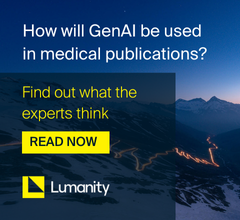Enhanced Communications: Digital, Visual, and Accessibility Innovations
Guidance, Education, Tools/Resources

Last update: October 2025; select content since 2024
Publication Extenders
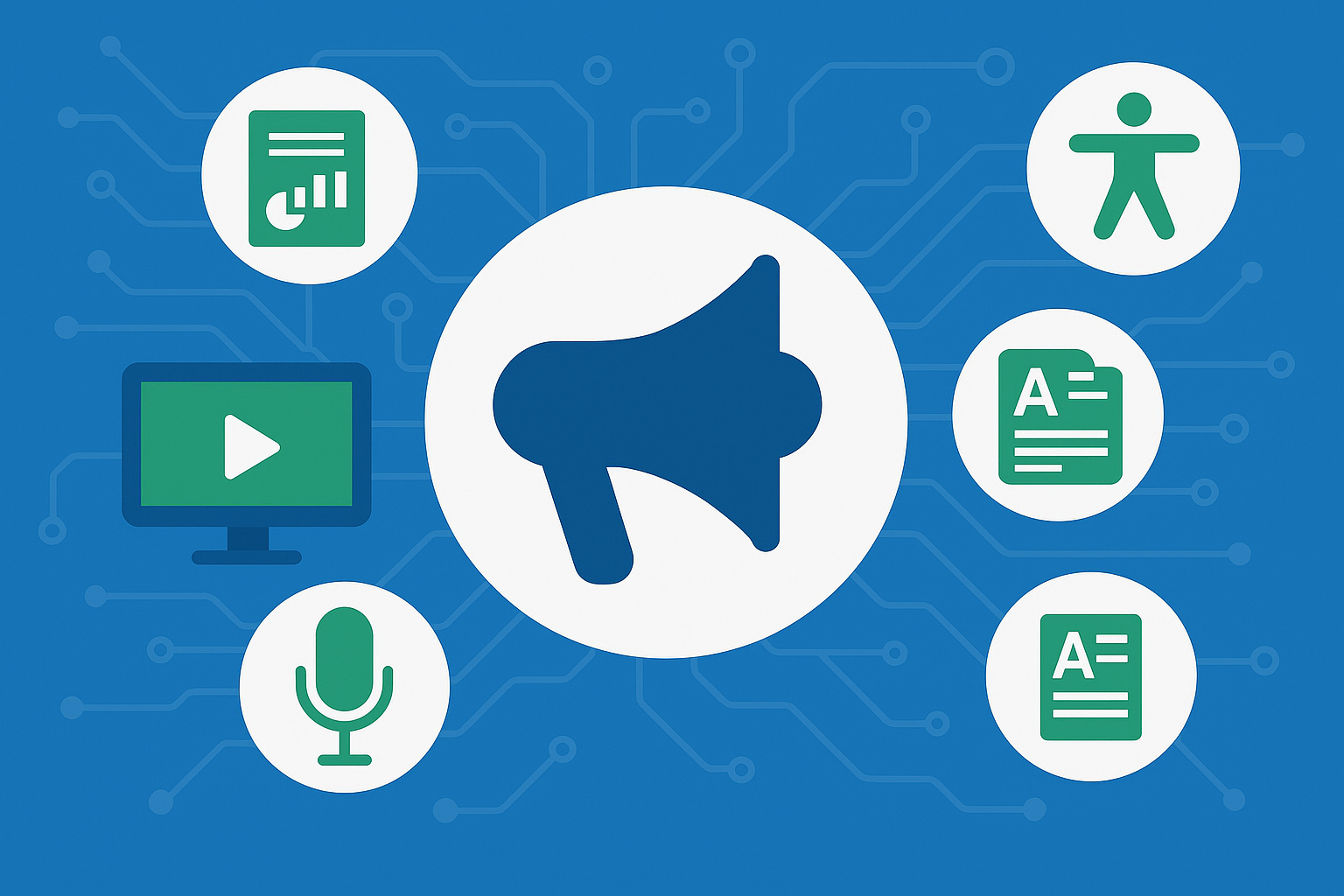 Over the past several years, publication extenders, also known as enhanced publication content or digital features, have become a gold-standard enhancement to peer-reviewed journal articles. Extenders include infographics, video abstracts, podcasts, and plain language summaries (PLS). Through its meeting programs, webinars, articles, and best practices guidances, developed by our member-volunteers, ISMPP provides resources related to the implementation of publication extenders as well as research that looks into extender impact, discoverability, and readability. Over the past several years, publication extenders, also known as enhanced publication content or digital features, have become a gold-standard enhancement to peer-reviewed journal articles. Extenders include infographics, video abstracts, podcasts, and plain language summaries (PLS). Through its meeting programs, webinars, articles, and best practices guidances, developed by our member-volunteers, ISMPP provides resources related to the implementation of publication extenders as well as research that looks into extender impact, discoverability, and readability.
A Toolkit for Harmonizing Publication Extenders – coming soon!
 Developed by members of the 2024-2025 Digital/Visual Communications Committee, the Publication Extenders Toolkit is designed to guide ISMPP members through the integration of publication extenders into their publication strategies. It is specifically focused on digital/visual publication extenders such as author videos, infographics, etc and aims to address the unmet needs of diverse audiences, cater to different learning styles, and ultimately, increase the reach and awareness of medical publications. Members can use the toolkit to explore the value (“why do it”) and the practical implementation (“what to do” and “how to do it”) of publication extenders. Developed by members of the 2024-2025 Digital/Visual Communications Committee, the Publication Extenders Toolkit is designed to guide ISMPP members through the integration of publication extenders into their publication strategies. It is specifically focused on digital/visual publication extenders such as author videos, infographics, etc and aims to address the unmet needs of diverse audiences, cater to different learning styles, and ultimately, increase the reach and awareness of medical publications. Members can use the toolkit to explore the value (“why do it”) and the practical implementation (“what to do” and “how to do it”) of publication extenders.
The MAP Newsletter article, Publication Extenders: Yes, They Are Worth the Effort
 As interest has steadily increased, so has the research looking into publication extender impact, uptake, discoverability, and readability. This article, by Kelly Soldavin (Taylor & Francis), Caroline Halford (Springer Healthcare), Adeline Rosenberg (Oxford PharmaGenesis), Joanne Walker (Becaris Publishing), and Hamish McDougall (Sage Publishing) and published in The MAP Newsletter on April 8, 2025, takes a question-and-answer approach to the evidence supporting the role of publication extenders in increasing impact and reach of scientific articles. As interest has steadily increased, so has the research looking into publication extender impact, uptake, discoverability, and readability. This article, by Kelly Soldavin (Taylor & Francis), Caroline Halford (Springer Healthcare), Adeline Rosenberg (Oxford PharmaGenesis), Joanne Walker (Becaris Publishing), and Hamish McDougall (Sage Publishing) and published in The MAP Newsletter on April 8, 2025, takes a question-and-answer approach to the evidence supporting the role of publication extenders in increasing impact and reach of scientific articles.
Publication Extenders Evidence Resource
The Publication Extenders Evidence Resource provides a summary of existing journal articles that demonstrate evidence for the effectiveness of digital/visual communications, such as video abstracts, infographics, and plain language summaries. The resource, available as of November 2024, is not a complete summary of all journal articles detailing evidence of the impact of publication extenders. It should be used as a guide to locate relevant evidence for your work; reading the full article is recommended, rather than relying only on the summaries provided.
The MAP Newsletter article, Engagement Evolution: How Metrics and Enhanced Publication Content Shape Readership
 By understanding metrics and factors influencing article readership and update of enhanced digital content, publication professionals can work to ensure that the right content reaches the right audience, and that publication enhancements are both tailored and accessible to their target audience. This article, by Alexa Holland (Costello Medical), Hamish McDougall (Sage), Radhika Bhatia (UCB), and Sarah J. Clements (Costello Medical) was published in The MAP Newsletter on November 19, 2024. By understanding metrics and factors influencing article readership and update of enhanced digital content, publication professionals can work to ensure that the right content reaches the right audience, and that publication enhancements are both tailored and accessible to their target audience. This article, by Alexa Holland (Costello Medical), Hamish McDougall (Sage), Radhika Bhatia (UCB), and Sarah J. Clements (Costello Medical) was published in The MAP Newsletter on November 19, 2024.
Design Innovation
 Effective scientific communication is not just about sharing data—it’s about making information resonate. In today’s fast-paced, visually driven environment, how research is presented can be just as important as what is being presented. This section highlights ISMPP’s resources that explore innovative design strategies—from engaging slide presentations and impactful data visualization to reimagined scientific posters—all aimed at helping professionals communicate with clarity, creativity, and influence. Effective scientific communication is not just about sharing data—it’s about making information resonate. In today’s fast-paced, visually driven environment, how research is presented can be just as important as what is being presented. This section highlights ISMPP’s resources that explore innovative design strategies—from engaging slide presentations and impactful data visualization to reimagined scientific posters—all aimed at helping professionals communicate with clarity, creativity, and influence.
ISMPP U – Designing Slide Presentations That Engage and Deliver
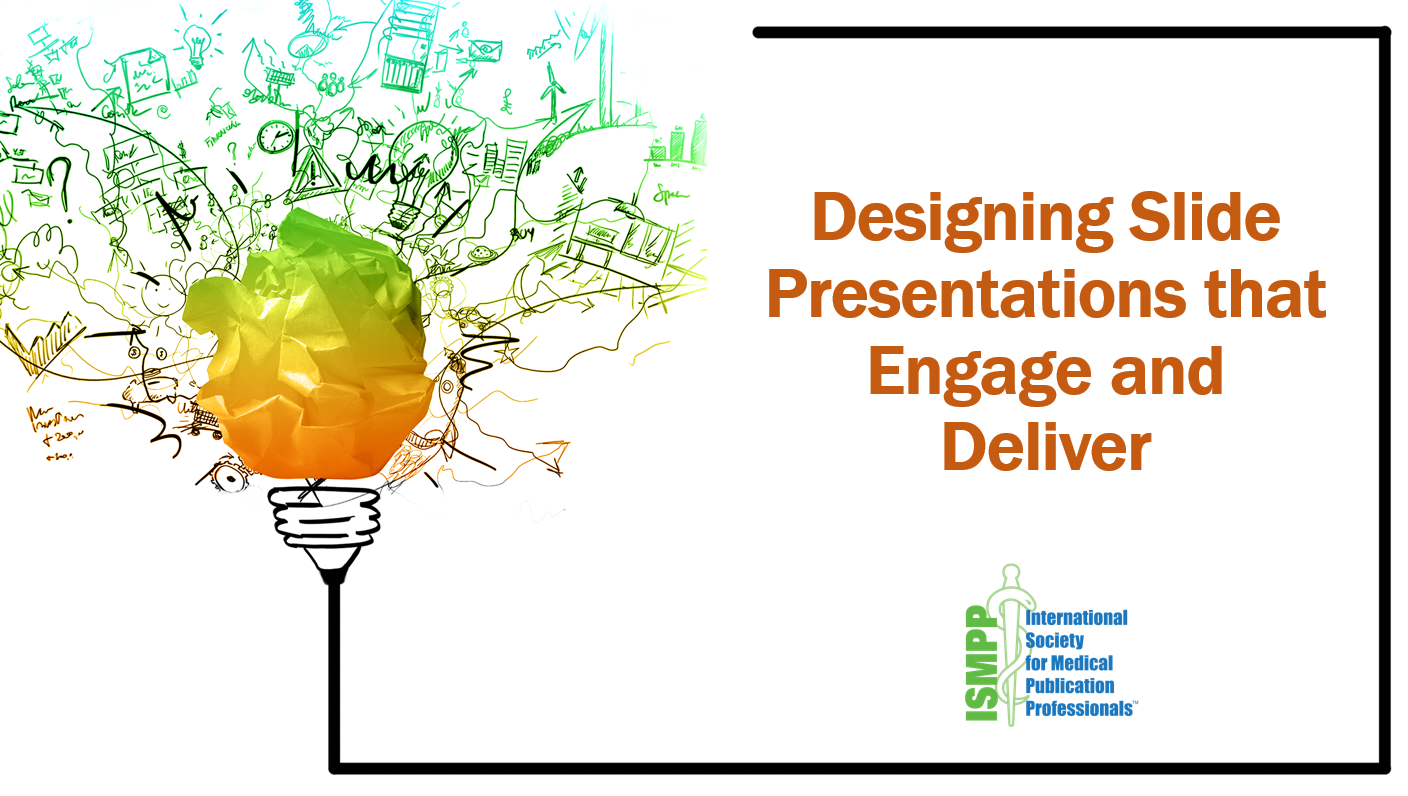 Presenting at a professional meeting is an opportunity, not just to inform, but to influence. Yet many well-intentioned sessions fall flat due to vague objectives, dense slides, or delivery that loses the audience before the message lands. This practical session, presented on August 27, 2025, by Steve Palmisano (The Lockwood Group), Ann Overton (Fingerpaint Medical), and Sonya Snedecor (Science Clarity), offers guidance to help presenters craft content that connects, communicates, and compels. It is a complimentary resource for ISMPP members and available for purchase by non-members. Presenting at a professional meeting is an opportunity, not just to inform, but to influence. Yet many well-intentioned sessions fall flat due to vague objectives, dense slides, or delivery that loses the audience before the message lands. This practical session, presented on August 27, 2025, by Steve Palmisano (The Lockwood Group), Ann Overton (Fingerpaint Medical), and Sonya Snedecor (Science Clarity), offers guidance to help presenters craft content that connects, communicates, and compels. It is a complimentary resource for ISMPP members and available for purchase by non-members.
ISMPP U – We're Not in Kansas Anymore: Harnessing the Power of Data Visualization
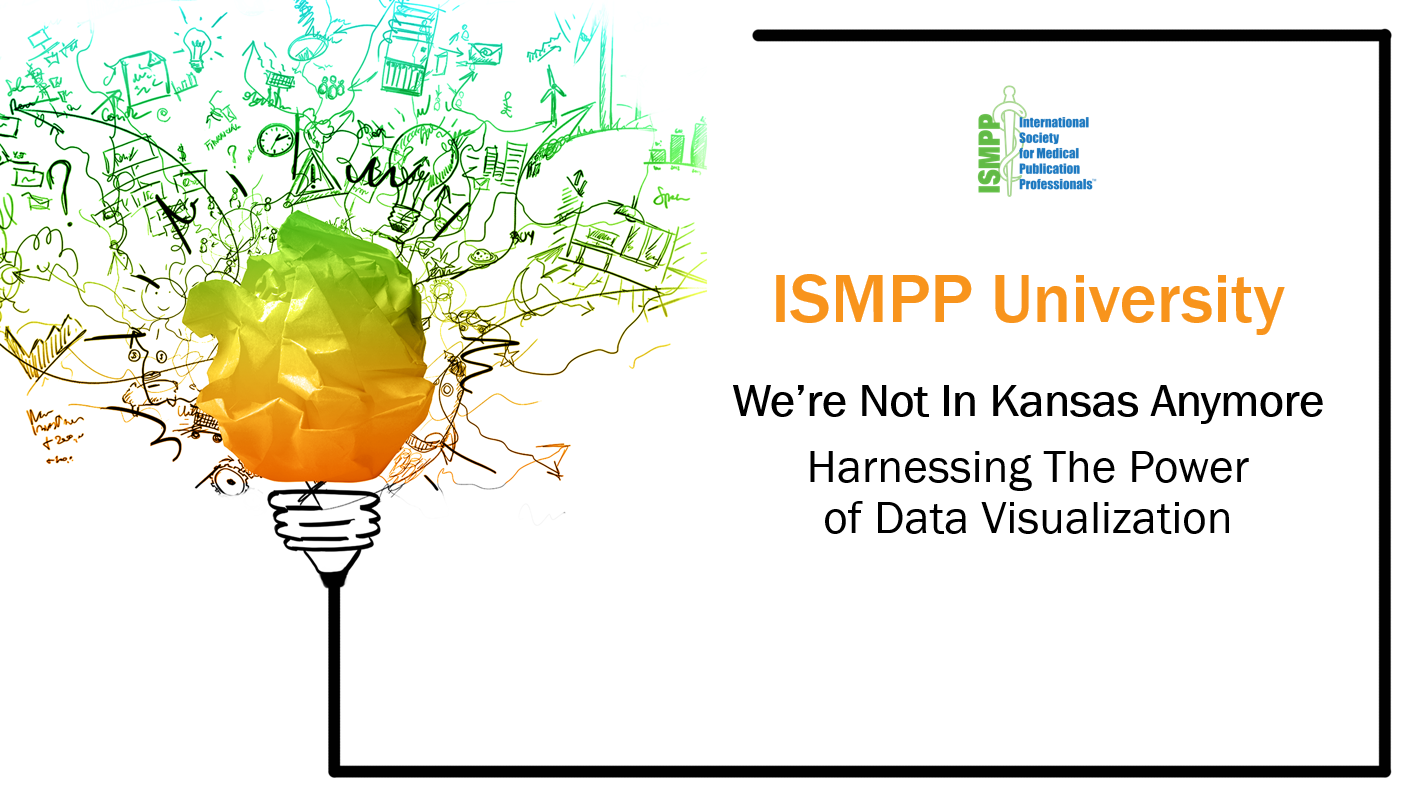 Typical scientific communications follow a traditional pattern for data presentation with complex figures, overloaded data tables and heavy text explanations. As health care professionals now live in a busy, complex, information rich world, your data must be easily digestible. This webinar, presented by Matt Brierley (Ashfield MedComms, an Inizio Company), Sean Taylor (Ashfield MedComms, an Inizio Company), Amy Kuang (AbbVie), and Amanda Hartley (Sage Therapeutics) on May 21, 2025, provides guidance on how to reimagine scientific communication with refined data visualization to attract readers and hold their attention. It is a complimentary resource for ISMPP members and available for purchase by non-members. Typical scientific communications follow a traditional pattern for data presentation with complex figures, overloaded data tables and heavy text explanations. As health care professionals now live in a busy, complex, information rich world, your data must be easily digestible. This webinar, presented by Matt Brierley (Ashfield MedComms, an Inizio Company), Sean Taylor (Ashfield MedComms, an Inizio Company), Amy Kuang (AbbVie), and Amanda Hartley (Sage Therapeutics) on May 21, 2025, provides guidance on how to reimagine scientific communication with refined data visualization to attract readers and hold their attention. It is a complimentary resource for ISMPP members and available for purchase by non-members.
In Plain Cite – Scientific Posters, Reimagined
In this podcast, released on March 4, 2025, In Plain Cite’s host and ISMPP’s President & CEO, Rob Matheis, sat down with Doreen Valentine (ISMPP and formerly Bristol Myers Squibb) to explore how digital innovation is reshaping the way research is presented. From interactive design to greater accessibility, they discuss what’s changing, why it matters, and how we can balance progress with scientific integrity.
Accessibility Approaches
Healthcare information has never been more readily available than it is now. However, accessibility goes beyond mere access to information; it encompasses ensuring that all individuals—regardless of physical, sensory, or cognitive ability—can access, understand, and benefit from healthcare content. Developed by members of the ISMPP Digital/Visual Communications Committee (2024-2025), resources include an article on easy steps to making healthcare information accessible and a tutorial on how to make accessible slides, posters, figures, and emails.
The MAP Newsletter article, Accessibility Matters: Easy Steps to Making Healthcare Information Accessible

This article, by Rachel Jenkins (Taylor & Francis), Dawn Nicewarner (Organon), Steve Palmisano (The Lockwood Group), and Kelly Soady (Oxford PharmaGenesis) was published in The MAP Newsletter on Sep 2, 2025. It discusses the benefits of accessible healthcare content, current accessibility standards, common barriers, and practical tools and strategies to enhance accessibility.
How to make accessible slides, posters, figures, and emails
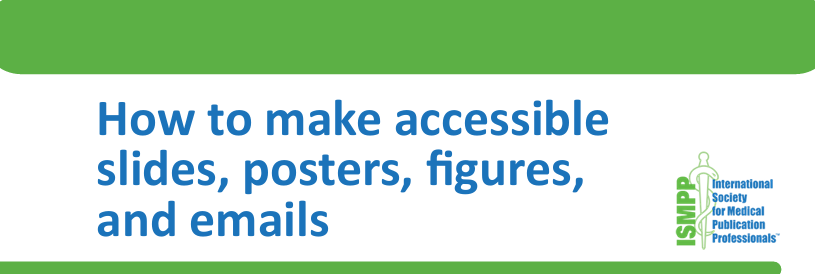 Accessibility means enabling understanding of your medical publications’ content by people with vision, hearing, physical, or cognitive limitations. Accessible materials make it possible for assistive devices to read digital content. This guide outlines the simple actions you can take to make your PowerPoint slides, posters, figures, and emails accessible. It includes detailed instructions for how to build in accessibility as you draft. The guide is a resource available only to ISMPP members. Accessibility means enabling understanding of your medical publications’ content by people with vision, hearing, physical, or cognitive limitations. Accessible materials make it possible for assistive devices to read digital content. This guide outlines the simple actions you can take to make your PowerPoint slides, posters, figures, and emails accessible. It includes detailed instructions for how to build in accessibility as you draft. The guide is a resource available only to ISMPP members.
Acknowledgments
Resources related to digital, visual, and accessibility innovations have been developed under the auspices of ISMPP committees led by member-volunteers or independently and collaboratively by members of the ISMPP community.
Thank you to members of the 2024-2025 Digital/Visual Communications Committee, co-chaired by Hamish McDougall, Lana Vegman, and Steve Palmisano, who have contributed to the Accessibility and Distribution workstream led by Steve: Anna Williams, Chirag Jay Patel, Dawn Nicewarner, Justin Sodano, Kelly Soady, Michelle Chadwick, Patrice Skelley, and Rachel Jenkins.
Thank you to these members of the 2023-2024 Digital/Visual Communications Committee for their development of the Publication Extenders Evidence Resource: Hamish McDougall, Committee Co-chair; Timothy Becker; Catarina Fernandes; Lynne Gordon; Caroline Halford; Lisa Havran; Adeline Rosenberg; Kaoru Sakabe; Samantha Weissman. Thank you also to these individuals for their contributions to the development of this resource: Kelly Soldavin, Jo Walker. All descriptions and summaries have been provided by the ISMPP Digital/Visual Communications Committee and may not reflect the opinions of ISMPP.
Thank you to the authors of articles published in ISMPP’s The MAP Newsletter and to the faculty contributors and moderators of ISMPP U webinars, program sessions and roundtables, and podcasts.
All contents © 2025 International Society for Medical Publication Professionals, Inc. (ISMPP). ISMPP will grant limited permission to use materials developed by ISMPP and ISMPP community volunteers for personal, non-commercial use. Such use is permitted only if you accept all of the terms and conditions contained in this nonexclusive, nontransferable, limited license agreement. Please read this license carefully before using the materials in any manner.
By using these materials, you hereby accept and agree that: use of the material, and their content, shall be for individual, personal, and non-commercial reference and use only; and, the material shall be used only pursuant to the terms of this license agreement. The material, and their content, are proprietary information of ISMPP and/or the individual authors. The contents of the material may not, in whole or in part, be reproduced, copied, disseminated, or otherwise utilized, in any form or manner or by any means, except for individual, personal, and non-commercial reference and use.
|

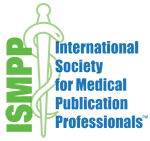

 Over the past several years, publication extenders, also known as enhanced publication content or digital features, have become a gold-standard enhancement to peer-reviewed journal articles. Extenders include infographics, video abstracts, podcasts, and plain language summaries (PLS). Through its meeting programs, webinars, articles, and best practices guidances, developed by our member-volunteers, ISMPP provides resources related to the implementation of publication extenders as well as research that looks into extender impact, discoverability, and readability.
Over the past several years, publication extenders, also known as enhanced publication content or digital features, have become a gold-standard enhancement to peer-reviewed journal articles. Extenders include infographics, video abstracts, podcasts, and plain language summaries (PLS). Through its meeting programs, webinars, articles, and best practices guidances, developed by our member-volunteers, ISMPP provides resources related to the implementation of publication extenders as well as research that looks into extender impact, discoverability, and readability. Developed by members of the 2024-2025 Digital/Visual Communications Committee, the Publication Extenders Toolkit is designed to guide ISMPP members through the integration of publication extenders into their publication strategies. It is specifically focused on digital/visual publication extenders such as author videos, infographics, etc and aims to address the unmet needs of diverse audiences, cater to different learning styles, and ultimately, increase the reach and awareness of medical publications. Members can use the toolkit to explore the value (“why do it”) and the practical implementation (“what to do” and “how to do it”) of publication extenders.
Developed by members of the 2024-2025 Digital/Visual Communications Committee, the Publication Extenders Toolkit is designed to guide ISMPP members through the integration of publication extenders into their publication strategies. It is specifically focused on digital/visual publication extenders such as author videos, infographics, etc and aims to address the unmet needs of diverse audiences, cater to different learning styles, and ultimately, increase the reach and awareness of medical publications. Members can use the toolkit to explore the value (“why do it”) and the practical implementation (“what to do” and “how to do it”) of publication extenders. As interest has steadily increased, so has the research looking into publication extender impact, uptake, discoverability, and readability.
As interest has steadily increased, so has the research looking into publication extender impact, uptake, discoverability, and readability.  By understanding metrics and factors influencing article readership and update of enhanced digital content, publication professionals can work to ensure that the right content reaches the right audience, and that publication enhancements are both tailored and accessible to their target audience.
By understanding metrics and factors influencing article readership and update of enhanced digital content, publication professionals can work to ensure that the right content reaches the right audience, and that publication enhancements are both tailored and accessible to their target audience.  Effective scientific communication is not just about sharing data—it’s about making information resonate. In today’s fast-paced, visually driven environment, how research is presented can be just as important as what is being presented. This section highlights ISMPP’s resources that explore innovative design strategies—from engaging slide presentations and impactful data visualization to reimagined scientific posters—all aimed at helping professionals communicate with clarity, creativity, and influence.
Effective scientific communication is not just about sharing data—it’s about making information resonate. In today’s fast-paced, visually driven environment, how research is presented can be just as important as what is being presented. This section highlights ISMPP’s resources that explore innovative design strategies—from engaging slide presentations and impactful data visualization to reimagined scientific posters—all aimed at helping professionals communicate with clarity, creativity, and influence. Presenting at a professional meeting is an opportunity, not just to inform, but to influence. Yet many well-intentioned sessions fall flat due to vague objectives, dense slides, or delivery that loses the audience before the message lands.
Presenting at a professional meeting is an opportunity, not just to inform, but to influence. Yet many well-intentioned sessions fall flat due to vague objectives, dense slides, or delivery that loses the audience before the message lands.  Typical scientific communications follow a traditional pattern for data presentation with complex figures, overloaded data tables and heavy text explanations. As health care professionals now live in a busy, complex, information rich world, your data must be easily digestible.
Typical scientific communications follow a traditional pattern for data presentation with complex figures, overloaded data tables and heavy text explanations. As health care professionals now live in a busy, complex, information rich world, your data must be easily digestible. 
 Accessibility means enabling understanding of your medical publications’ content by people with vision, hearing, physical, or cognitive limitations. Accessible materials make it possible for assistive devices to read digital content.
Accessibility means enabling understanding of your medical publications’ content by people with vision, hearing, physical, or cognitive limitations. Accessible materials make it possible for assistive devices to read digital content. 
